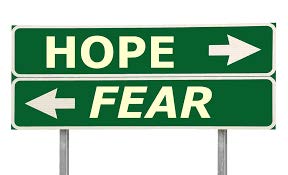 People think and act based on many influences, but two stand out as more influential than most – fear and hope. Both fear and hope drive us to act in ways we would not otherwise. Fear, for example, drives people to install home security systems and say “no” to risky business ventures. Hope drives people to go to college, start new businesses, and visit exciting destinations. These actions are all beneficial, but does that mean that fear and hope are equally good motivators?
People think and act based on many influences, but two stand out as more influential than most – fear and hope. Both fear and hope drive us to act in ways we would not otherwise. Fear, for example, drives people to install home security systems and say “no” to risky business ventures. Hope drives people to go to college, start new businesses, and visit exciting destinations. These actions are all beneficial, but does that mean that fear and hope are equally good motivators?
Some people, “command and control” style managers for example, use fear to motivate people. They use their power of authority. “If you can’t get this job done, I’ll find someone else who can” is a phrase they often use. Some are a bit more subtle. They might say “I don’t think you can get this done” hoping their reverse psychology will make people mad and motivate them to work hard to prove them wrong. When people get mad about something, some walk away in disgust, but others become driven and take action.
People who use fear to drive action come across as bullies. Their pushing style demeans people. They use threats and intimidation which make people take action, but out of cowardice rather than confidence.
Managers, parents, and friends who say things like “If you don’t stop that, you are going to fail” focus people on what not to do instead of what to do. Threatening language often puts people’s focus on exactly the opposite of what they should be focused.
A common purveyor of fear tactics are product advertisers who appeal to people’s insecurities. Fear based advertisements emphasize dangers and risk. Like politicians, marketers who use fear appeal can be very effective. Psychological studies find that people give more attention to not losing something than gaining something. Fear is a powerful emotion.
Hope is very different than fear. Hope turns feelings of fear, despair, and anger into anticipation. Hope is about the future possibility of something good in contrast to the future possibility of something bad. Hope is a positive feeling rather than an unpleasant one. Even when there is the future possibility of something bad, hope gives people strength and purpose. Like fear, hope makes people work hard to achieve something. Hope, for example, drives people with medical conditions to work toward getting well again. It drives people who grow up in poverty or third-world countries to rise above their adversity.
What drives and motivates you – fear or hope? Do you like striving toward something positive? Or staying away from something negative? Do you like thinking about a future reward or punishment? Most people would rather dwell on happy thoughts.
So it seems obvious that leaders, parents, and friends should use hope to stir people to action, yet many don’t.
If you’ve ever said any of the following, you chose to focus on fear rather than hope:
• “If you make that mistake again, you are going to be punished.”
• “Quit doing that or I’m going to leave.”
• “Find a way to overcome that issue or I’ll find someone else who can.”
• “If you lose that opportunity, you won’t get a bonus.”
In each of these statements the focus is placed on what not to do instead of what to do. They invoke fear because they emphasize the bad outcome rather than the good one.
Here are the same points, but with positive language that creates hope:
• “If you keep doing that right, you’ll have a bright future.”
• “I love being with you when you do that.”
• “I believe in you and will help you achieve that goal.”
• “Imagine what you’ll be able to do with your bonus when you win that opportunity.”
Consider the language you use with your employees, spouse, children, friends, and family. Sometimes the difference between fear and hope language is subtle, but the impact can be significant. Consider how you might create hope rather than fear. Fear is powerful, but hope trumps fear. Hope for a better future is what drives people toward amazing achievements. Hope builds courage and confidence. If you use fear, use it sparingly to get people’s attention, then turn attention to the better future ahead. Help people put their energy toward what they should be doing instead of wasting it on what they shouldn’t be doing. Create inspiration rather than inhibition.
Article by Mike Hawkins, award-winning author of Activating Your Ambition: A Guide to Coaching the Best Out of Yourself and Others (www.ActivatingYourAmbition.com), author of the SCOPE of Leadership six-book series on coaching leaders to lead as coaches (www.ScopeOfLeadership.com), and president of Alpine Link Corp (www.AlpineLink.com), a boutique consulting firm specializing in leadership development and sales performance improvement. For other articles on reaching your peak potential, visit: www.alpinelink.com/blog
